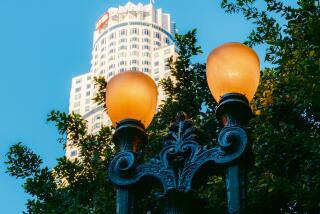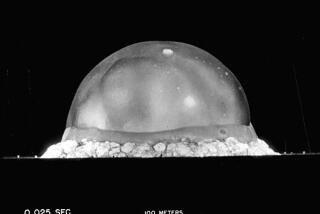The Electric Revolution
- Share via
Sampson and Bertha Mae Stillman of rural Dobson, N.C., got electricity last year. The electric lines had gone past their home in the late 1940s, but they never hooked up to them. They figured they didn’t need electricity, they said.
But at 84, Sampson realized that his eyesight was not good enough to read by kerosene lamp anymore. So the Stillmans yielded and had electric lights put in. That done, some relatives offered to give them electric appliances, including a washing machine and a refrigerator.
“You can give us one if you want to, but we sure ain’t going to go out and buy one,” Bertha Mae told her kin. “We ain’t going to spend good money on something like that.”
In 1984, the Stillmans experienced what millions of people have gone through since Thomas Alva Edison invented the incandescent light bulb on Oct. 21, 1879. Electric light revolutionized the way people live and think by touching off the electrification of America, which wasn’t completed until after World War II. Along the way, electricity became an indispensable part of modern society, a symbol of 20th-Century technology and civilization.
The equation of light and progress is not limited to the Western world. Lenin said that communism is Marxism plus electricity. Everywhere the light bulb brought electricity to the masses.
Electricity was known long before Edison, and various electric lights had been invented before him, but his incandescent bulb was the first that could be used in homes and factories. The demand for it was immediate and enormous. Along with the bulb--and just as important--Edison invented a system for generating, distributing and metering electricity. The bulb made it economically feasible to wire up cities. Once electricity was installed, inventors and entrepreneurs found a myriad other uses for it besides providing light after sunset.
In Los Angeles, the coming of electricity meant the growth of mass transit, which sparked a population boom. Streetcars first appeared here in 1874, powered by horses, mules and cables. The first line was electrified in 1887. By 1925, the Pacific Electric Railway Co. operated a total of 1,110 miles of track. Meanwhile, in the decade from 1900 to 1910, the population of the Los Angeles metropolitan area increased by more than 180%--from 180,920 to 507,300--its largest percentage increase of this century.
The thrill and wonder of bright light at the flip of a switch is all but forgotten now, but it was one of the marvels of the late 19th and early 20th centuries. Edison’s electric lights were major displays at the world’s fairs in London, Paris, Vienna and Cincinnati during the 1880s. The Chicago World’s Fair of 1893 was lit by 93,000 light bulbs, 10 times more than had ever been used before. Lighting continued as a major attraction of the world fairs in the Buffalo in 1901, San Francisco in 1914 and New York in 1939.
But the electrification of America proceeded slowly. In 1900, fewer than 8% of the homes in this country had electric light; by 1920, one-third were electrified, and in 1925, half were.
Plenty of folks still alive remember the time before electricity. “You had to get everything done in the daytime, because when it got dark, that was it,” said Claudia Leatherwood, who was interviewed for an oral history project this year marking the 50th anniversary of the New Deal’s Rural Electrification Administration. “You came in early. Went to bed ‘with the chickens,’ got up when the rooster crowed.”
After the invention of the light bulb, people looked at light differently, according to Bernard S. Finn at the Smithsonian Institution. Until this century, light in literature was associated with God, beauty and truth; today, it represents power, civilization and technical progress. Finn, head of the division of electricity at the Institution’s Museum of American History, quotes the Book of John as an example: “Then spake Jesus unto them, saying, ‘I am the light of the world: he that followeth me shall not walk in darkness, but shall have the light of life.’ ”
He contrasts this with Pablo Picasso’s epic mural “Guernica,” which commemorates the bombing of that city during the Spanish Civil War. In the top center of the canvas, overlooking the destruction below, there is an eye-shaped sun. Inside the sun is a light bulb. “This eye, this sun, this electric light I interpret as the eye of the civilized world, which is sitting by and watching Guernica be savaged,” Finn said in an interview.
The breathtaking skyline of a city is inextricably linked to the thousands of light bulbs that bring it alive. In 1888, a writer in the Electrical Review, a long-defunct publication, observed, “From the shore of Staten Island, New York on a dark night looks like a fairyland; a thousand electric lights dancing from out of a sea of inky gloom.”
In recent years, some people have argued that electricity is not the unalloyed blessing that earlier generations thought it was. Edison’s invention of the central generating station has been called both technically and socially wrong, placing control in the hands of a few. But so far, alternative technologies have been unable to match the output of a conventional power plant.
In the meantime, there is no turning back from the electric light and its progeny. When cities have been blacked out in recent decades, they have been paralyzed and rendered helpless. Those who yearn nostalgically for the “good old days” forget what life was like before Edison’s electric light.
More to Read
Sign up for Essential California
The most important California stories and recommendations in your inbox every morning.
You may occasionally receive promotional content from the Los Angeles Times.













